Iraq is a country rich in history and diverse landscapes. Not only that, this country, with its arid climate and vast wilderness, is also home to a variety of spiders that can evoke fear in even the bravest of souls. It harbors several species of spiders that possess formidable characteristics and venomous bites. From stealthy hunters to venomous lurkers, these arachnids can instill a sense of dread with their unique adaptations and striking appearances.
In this article, we delve into the realm of these eight-legged creatures and uncover the ten most terrifying spiders in Iraq. We will shed light on their distinctive features and dangers to human encounters. Brace yourself as we unravel the eerie world of spiders lurking within the borders of Iraq.
1. Camel Spiders
Iraq is closely associated with the dangerous camel spider. Camel spiders rose to notoriety in 2003 during the American invasion of Iraq when US soldiers told tales of giant spiders. Some even said they were as tall as men and moved with lightning speed. They also said the spiders could eat a whole camel, hence the camel spider. Cue everything that would make an animal appear a menace.
Only a few things about the spider were true, though. Yes, the spiders can move at lightning speed. They are also quite huge, with enormous jaws and frighteningly hairy bodies. But no, they aren’t as tall as a man. The spiders also resemble scorpions, earning them names such as the wind scorpions.
Camel spiders can move at a speed of up to 10 miles per hour. That makes them terrifyingly fast. They also have a rather painful bite, though they aren’t venomous. Camel spiders aren’t even true spiders, despite the name. They belong to the order Solifugae, not Arachnida. Camel spiders can grow as much as 6 inches long. That might explain why most foreigners found them terrifying. They love shrublands and deserts, where they lead nocturnal lives.
Camel spiders eat small birds, rodents, insects, and lizards. They aren’t deadly to humans as the many myths on the web would want you to believe.
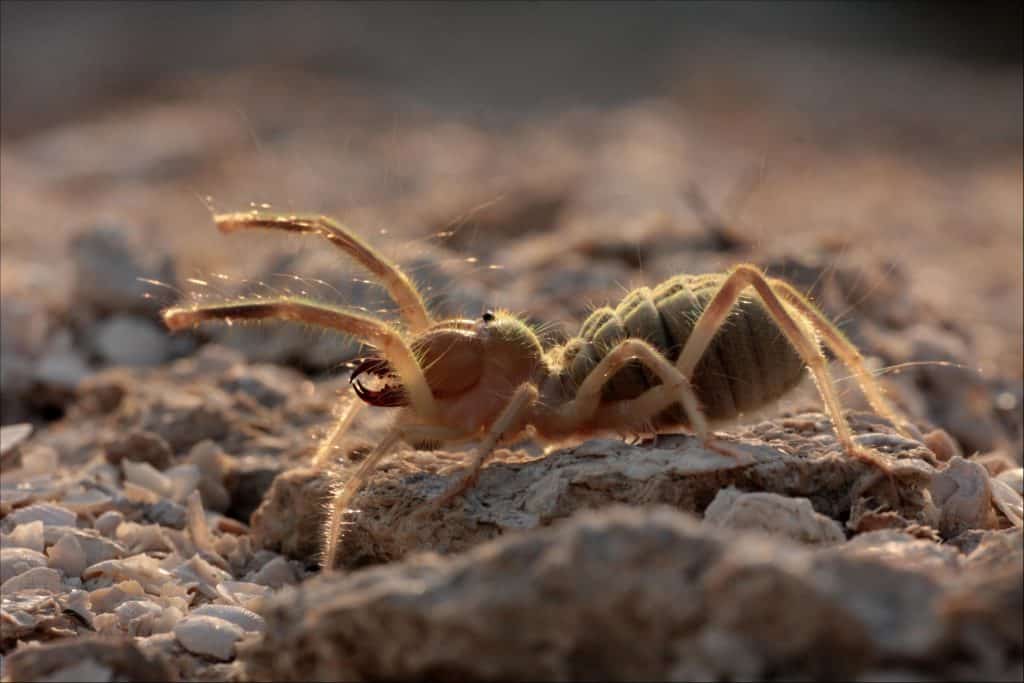
Camel spiders can move at a speed of 10 miles per hour and can grow as much as 6 inches long.
©Dmitry Fch/Shutterstock.com
2. Black Widow Spider
These spiders, though natives of Australia, are also in Iraq. Tourists could have carried them to the Asian nation. Black widow spiders have a reputation as venomous spiders and their potential danger to humans.
It was estimated they account for up to 10,000 bites of all human spider bites. While most spiders are venomous but not dangerous to humans, black widow spiders are a real danger.
Two black widow spider types were discovered in Iraq in 2012 and 2013. One was the redback species, and the other was the dark widow spider. However, today the black widow spider most likely to be in Iraq is the redback widow spider. Like its close relatives, redback females also eat the male. These are some of the most infamous spider species.
Redback spiders have a red streak on their dark abdomen. The color differentiates them from the other black widow spiders common in Australia. Like camel spiders, Iraqi black widow spiders have something to do with the US invasion of Iraq.
In 2016 locals complained that US soldiers brought the spiders into the country in biological warfare. They called the spiders American black widow spiders. Being able to inflict painful bites, you would understand the concerns of the Iraqi people who kept finding the spiders invading their homes.
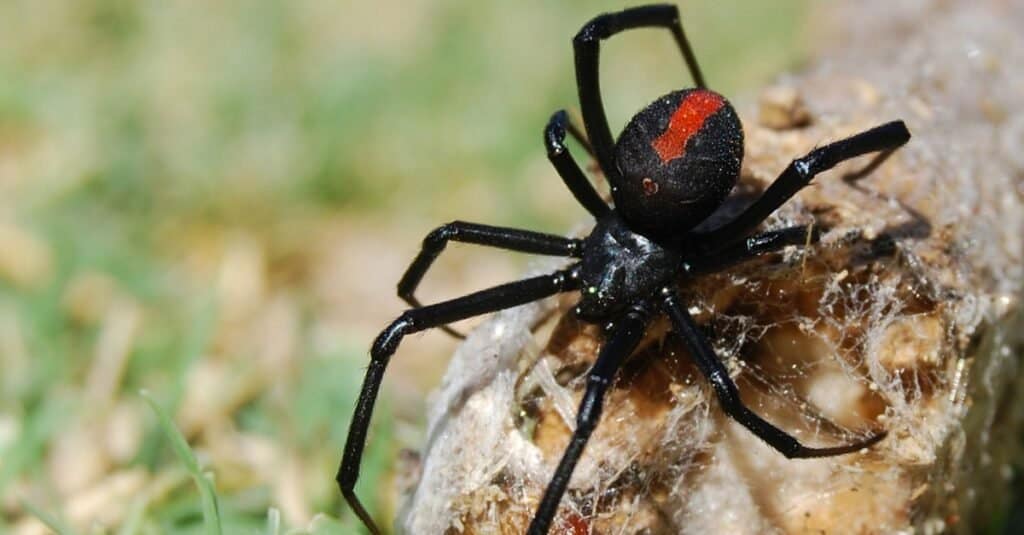
The redback spider is the most likely widow to be found in Iraq.
©iStock.com/maria72
3. Tarantula
Tarantulas are red, black, or mixed brown spiders, pretty common spiders in Iraq and Kuwait. Their body easily blends with the ground thanks to their color and the hairs covering their bodies.
The terrifying feature of tarantulas is their size. These arachnids can be as large as 2 inches and have large fangs they use to bite prey. Tarantulas have a fearsome appearance and can also move exceptionally fast when they want to.
Despite being relatively fast, they aren’t the most efficient runners. They prefer to feel the ground for vibrations with their hair and legs. They also have good eyesight, likely from hunting for food at night.
Tarantulas, even with their fearsome looks, aren’t threatening to humans. The spiders predominantly live in the world’s desert, subtropical, and tropical areas. That’s why you’re likely to encounter them in Iraq.
Unless you corner them, tarantulas will rarely attack humans. They prefer to run, hide in their burrows, and wait to come out at night looking for food. Though venomous, their bite isn’t harmful to humans and has the same pain as a bee sting.
However, a bite could lead to an anaphylactic reaction in some people, leading to other complications. It’s, therefore, a wise decision to stay well out of their way.

Unless cornered, tarantulas rarely bite humans, mostly preferring to run and hide in their burrows until nighttime when they come out to eat.
©iStock.com/skydie
4. Yellow Sac Spider
The yellow sac spider is so named thanks to its behavior of hiding in a sac in the daytime. The colors can be pale yellow or pale green, red, or orange-brown further lending credence to their name.
These spiders aren’t that big. Their tendency to wander in people’s living quarters makes them terrifying. They are another species of spider that account for many spider bites.
Yellow sac spiders are tiny (about 0.39 inches or 10 millimeters), making it hard to see them, which could be a significant reason they bite people that much.
Besides the yellow sacs, you can only know their presence once they bite you. Their bites can cause redness, swelling, or itchiness on the skin. You’ll also feel a burning sensation once the spider bites you. Sometimes severe bites could kill the surrounding tissues of the bitten area. Like most spiders, they’re nocturnal.

Yellow sack spider bites can cause redness, itchiness, and a burning sensation, with some severe bites causing the death of surrounding tissue.
©Brett Hondow/Shutterstock.com
5. Lobed Argiope
Female lobed Argiope spiders can grow to a terrifying body length of 1 inch. The females also have a jagged abdomen that gives off the appearance of lobes, giving them their name. They also have unique coloration that is easy to see. Males are usually relatively small, won’t terrify you much, and lack lobes.
Beyond the size of the females, there’s nothing about these spiders that will terrify you. They could even fascinate you with the spectacular webs they build. Web decoration is a common ability among Argiope spiders. They form silky zigzag patterns at the center of their web, creating a beautiful sight.
The web is believed to be colorful to attract flies and other insects. Lobed Argiope spiders catch their prey by biting them and injecting poison.
Though these spiders can bite humans whenever they feel threatened, they’re generally harmless. The bite will only cause localized redness or swelling and mild pain. Therefore, if you meet this spider on your forays into Iraq, you have nothing to fear.

Web decoration is a fascinating ability of
Argiopespiders. Their webs usually comprise zigzag patterns at their center.
©iStock.com/Franang
6. Wolf Spiders
Wolf spiders are next on the list of the most terrifying spiders in Iraq. Their name alone might make you think these spiders have physical similarities with wolves. On the contrary, these spiders get their name from their method of getting food.
Wolf spiders ruthlessly stalk and kill their prey like wolves. These spiders have limited web-building capabilities. Because their webs are rudimentary and can’t capture prey, they resort to hunting and capturing prey. Interestingly, female wolf spiders walk around with their young strapped onto their backs when hunting for food. As this study found out, that often limits their ability to capture prey.
These carnivorous spiders are integral to the ecosystem. They help maintain an ecological balance by regulating the population of tiny insects such as ants and grasshoppers. Wolf spiders also help contain populations of harmful insects, such as aphids, in wheat fields.
These spiders use their fangs to inject toxins and suck fluid from their bodies. They sometimes use their chelicerae to chew their prey into a ball and extract their juices. Wolf spiders pose little to no threat to humans, even if they are venomous. Their bites are harmless as well unless you’re allergic to the venom.
Fun Fact: Though they aren’t huge, wolf spiders can sometimes eat tiny toads or frogs!
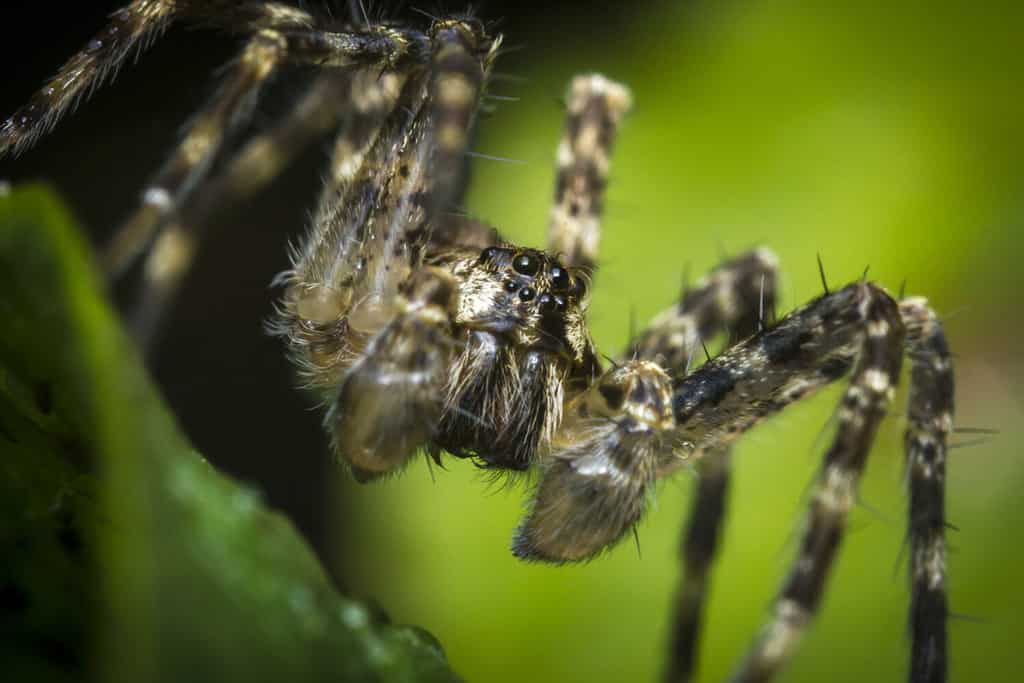
Wolf spiders ruthlessly stalk and kill their prey like wolves.
©Ezume Images/Shutterstock.com
7. Pantropical Jumping Spider
Spiders that can jump great distances can be pretty terrifying. Yet that’s precisely what pantropical jumping spiders do. They’re usually large, with both males and females ranging from 0.35-0.47 inches (9-12 millimeters) long. Males are on the smaller side of this number.
Besides the size, the males and females of this spider species vary in appearance. Males are usually black, with a wide strip of white down the middle of their body to the abdomen.
Females have large round dark eyes and darker barks. They’re also usually brownish gray with a wide tan that extends from their head to their abdomen. Like wolf spiders, pantropical jumping spiders hunt for food.
These spiders don’t build any webs that will help them attract and catch prey. They only have small silken retreats where they lie and wait. The spiders use their incredible athletic skills to monitor for targets and jump to capture them.
They also don’t attack only at night like most spiders. Instead, they hunt primarily during the day. When hunting at night, they wait near light sources to catch light-loving insects.
Pantropical jumping spiders are terrifying spiders by their appearance only. Other than that, they aren’t harmful to humans. They can only bite if you threaten them or handle them roughly. Their bite, at worst, feels like being stung by a bee.
Fun Fact: So impressive is their athletic ability that the spider can cover great distances with a single jump. Besides tiny insects, these spiders feed on nectar, pollen, and other spiders!
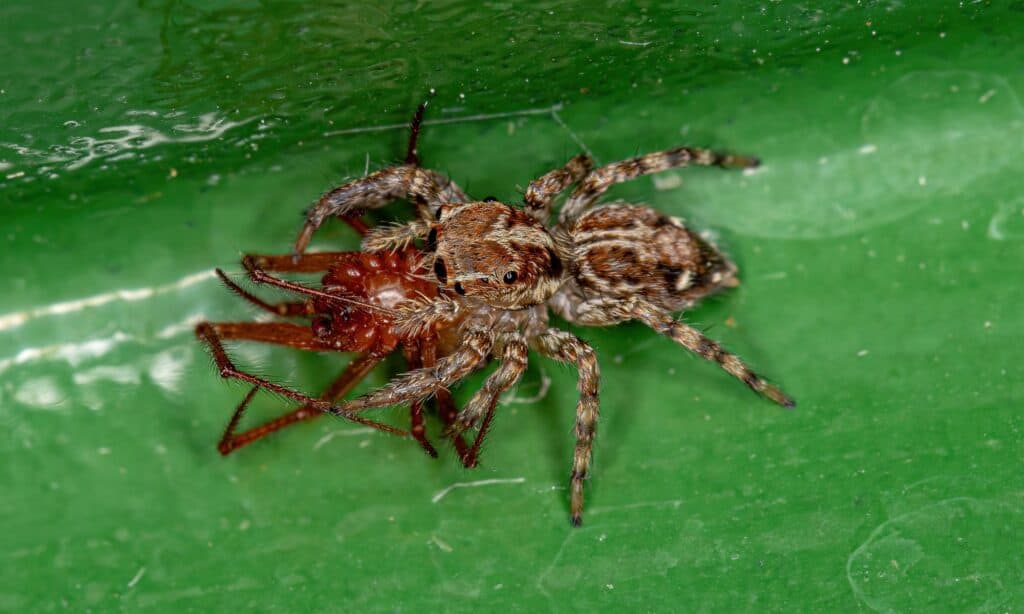
Unlike other spider species, these spiders mostly hunt during the day and can cover a great distance with a single jump.
©Vinicius R. Souza/Shutterstock.com
8. Crab Spiders
Crab spiders are other spiders that would terrify you because of their size. Though not that huge, females can grow to a maximum length of 0.43 inches or 11 millimeters, while males only get to a third of this.
Crab spiders can be any color. However, brown, green, pink, yellow, and white are the most common.
Like a few others on this list, these spiders don’t use webs to secure meals. They sit by plants and wait for insects to capture them for food. That makes them a terrifying menace to plant-destroying insects. Sometimes they survive on nectar and pollen when insects are in short supply.
Fun Fact: Plants form a mutualistic relationship with crab spiders, benefiting from their predation on harmful insects. Some plants release chemical signals to attract crab spiders during insect attacks. However, whether the spiders respond in time is anyone’s guess.

Plants form a mutualistic relationship with crab spiders, benefiting from their predation on harmful insects.
©HWall/Shutterstock.com
9. Huntsman Spiders
The specific species of huntsman spider in Iraq is the Eusparassus mesopotamicus. These are medium to large-sized spiders that can be pale gray or dark brown and have large legs.
Huntsman spiders live in arid or semiarid areas under rock or log cracks. An adaptation to this way of living has flattened bodies. Their exceptionally long legs also have joints that allow them to move flat on the ground to enter narrow spaces.
That ability to twist their legs in a crablike fashion has seen them earn the name of giant crablike spiders. The most terrifying aspect of these spiders is their size.
They grow to lengths of between 0.39-1.18 inches (10-30 millimeters). That makes them one of the most terrifying spiders to encounter in Iraq. Huntsman spiders are notorious for getting into cars or sometimes houses. However, not all species do this.
They feed on small invertebrates, primarily insects. Huntsman spiders can sting humans if provoked. Their bites are, however, not that dangerous, and a cold pack is all you need to relieve the pain.
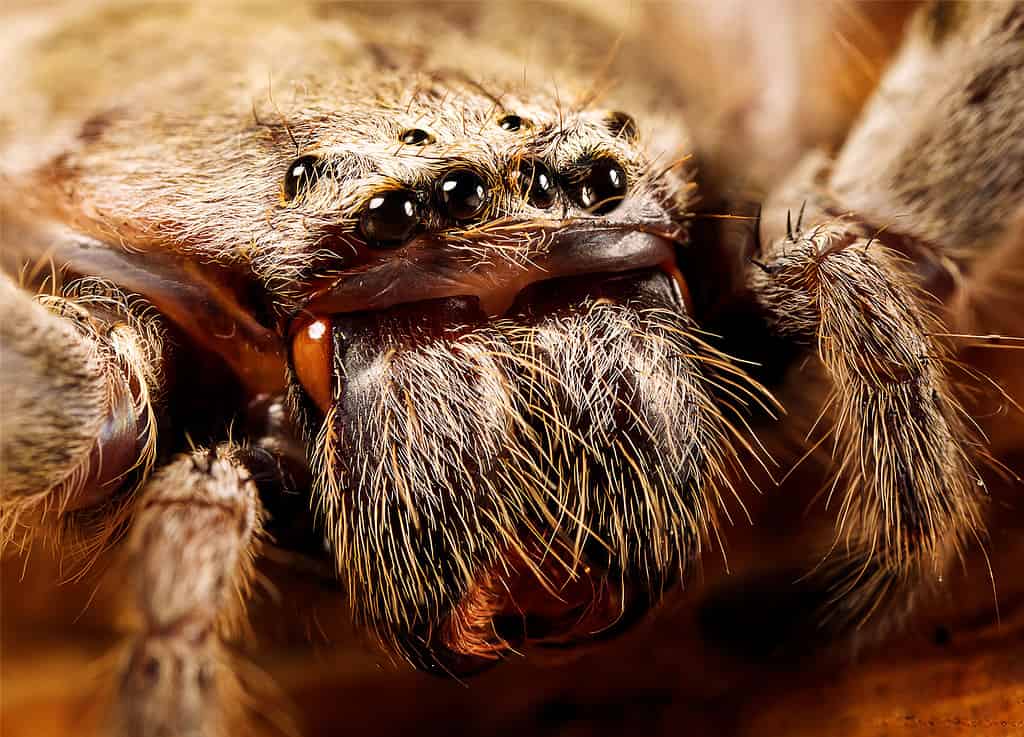
Huntsman spiders have joints that allow them to move flat on the ground to enter narrow spaces.
©Paul Looyen/Shutterstock.com
10. Banded Garden Spider
Another rather terrifying spider in Iraq is the banded garden spider. This spider has mysterious, bright markings all over its body and has an oval abdomen with black lateral striped lines at the back of the abdomen, hence the name. Silvery hairs also line the spider’s abdomen. These hairs sometimes make the males appear rather pale.
Banded garden spiders are enormous spiders. Females can grow to be around 0.51-0.59 inches (13-15 millimeters) long. Males are usually smaller and only grow to a maximum length of a third of the females.
Fascinatingly, these spiders build some of the stickiest webs. These sticky orb-shaped webs can trap giant insects such as locusts and wasps. These webs can have a massive diameter of up to 24 inches.
At the center is a dense silk network of zigzags that most likely attracts prey to its death. Another exciting thing about these spiders is how they position themselves to take advantage of the sun’s warmth.
They position their webs and thus themselves to face east to get as much warmth as possible. The heat ensures they survive the colder parts of the year with little sun.
Banded garden spiders aren’t usually aggressive. They could bite if you bothered them too much, but their bite is harmless.

The banded garden spider has an oval abdomen with black lateral striped lines at the back of the abdomen, hence the name.
©Protasov AN/Shutterstock.com
Iraq’s Creepiest Spiders
Iraq has some terrifying spiders, as the list shows. While camel, huntsman, and pantropical jumping spiders can be creepy, they aren’t as fear-inducing as the black widow.
Iraq has about three black widow species, a spider that strikes fear into most arachnophobes. You don’t need a morbid fear of spiders to be afraid of the black widow. Knowing the power of its venom is enough.
While the black widow is terrifying, the camel, crab, banded garden spider, and others on the list only threaten in appearance. They make up for what they lack in venom and aggression with eerie features that would terrify most people. However, most of the terrifying spiders in Iraq are relatively harmless and won’t threaten humans unless they bother them.
However, it’s wise to keep your distance whenever you encounter these spiders. By exploring the world of these ten terrifying spiders found in Iraq, we gain a deeper appreciation for the complexities of nature and the inherent beauty within these formidable creatures. So, next time you venture into the wilderness of Iraq, be cautious and watch for these eight-legged inhabitants.
The photo featured at the top of this post is © iStock.com/ePhotocorp
Thank you for reading! Have some feedback for us? Contact the AZ Animals editorial team.







